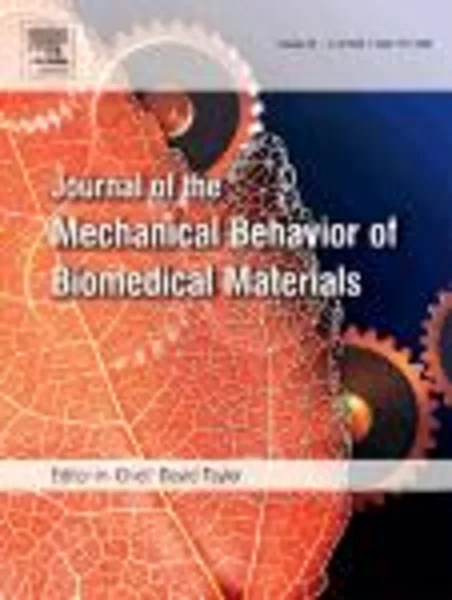-
in vitro degradation, flexural, compressive and shear properties of fully bioresorbable composite rods
جزئیات بیشتر مقاله- تاریخ ارائه: 1394/01/01
- تاریخ انتشار در تی پی بین: 1394/01/01
- تعداد بازدید: 899
- تعداد پرسش و پاسخ ها: 0
- شماره تماس دبیرخانه رویداد: -
several studies have investigated self-reinforced polylactic acid (sr-pla) and polyglycolic acid (sr-pga) rods which could be used as intramedullary (im) fixation devices to align and stabilise bone fractures. this study investigated totally bioresorbable composite rods manufactured via compression moulding at ∼100 °c using phosphate glass fibres (of composition 50p2o5–40cao–5na2o–5fe2o3 in mol%) to reinforce pla with an approximate fibre volume fraction (vf) of 30%. different fibre architectures (random and unidirectional) were investigated and pure pla rods were used as control samples. the degradation profiles and retention of mechanical properties were investigated and pbs was selected as the degradation medium. unidirectional (p50 ud) composite rods had 50% higher initial flexural strength as compared to pla and 60% higher in comparison to the random mat (p50 rm) composite rods. similar initial profiles for flexural modulus were also seen comparing the p50 ud and p50 rm rods. higher shear strength properties were seen for p50 ud in comparison to p50 rm and pla rods. however, shear stiffness values decreased rapidly (after a week) whereas the pla remained approximately constant. for the compressive strength studies, p50 rm and pla rods remained approximately constant, whilst for the p50 ud rods a significantly higher initial value was obtained, which decreased rapidly after 3 days immersion in pbs. however, the mechanical properties decreased after immersion in pbs as a result of the plasticisation effect of water within the composite and degradation of the fibres. the fibres within the random and unidirectional composite rods (p50 rm and p50 ud) degraded leaving behind microtubes as seen from the sem micrographs (after 28 days degradation) which in turn created a porous structure within the rods. this was the main reason attributed for the increase seen in mass loss and water uptake for the composite rods (∼17% and ∼16%, respectively).
مقالات جدیدترین رویدادها
-
استفاده از تحلیل اهمیت-عملکرد در ارائه الگوی مدیریت خلاقیت سازمانی و ارائه راهکار جهت بهبود
-
بررسی تاثیر ارزش وجوه نقد مازاد بر ساختار سرمایه شرکت های پذیرفته شده در بورس اوراق بهادار تهران
-
بررسی تأثیر سطح افشای ریسک بر قرارداد بدهی شرکت های پذیرفته شده در بورس اوراق بهادار تهران
-
بررسی تأثیر رتبه بندی اعتباری مبتنی بر مدل امتیاز بازار نوظهور بر نقد شوندگی سهام با تأکید بر خصوصی سازی شرکت ها
-
تأثیر آمیخته بازاریابی پوشاک ایرانی بر تصویر ذهنی مشتری پوشاک ایرانی (هاکوپیان)
-
اثر جو ایمنی بر بهره وری نیروی انسانی در پروژه های تخریب ساختمانی
-
بررسی مفاهیم مدیریت الکترونیک و رهبری الکترونیک
-
بررسی اثربخشی شفقت درمانی برکیفیت زندگی و متابعت درمانی بیماران مبتلا به رماتیسم
-
تحلیل مدیریت و ارزیابی ریسک در خط 2 متروی کرج با استفاده از ساختار پروژه
-
بررسی مدل های ترسیب کربن در مدیریت جنگل
مقالات جدیدترین ژورنال ها
-
مدیریت و بررسی افسردگی دانش آموزان دختر مقطع متوسطه دوم در دروان کرونا در شهرستان دزفول
-
مدیریت و بررسی خرد سیاسی در اندیشه ی فردوسی در ادب ایران
-
واکاوی و مدیریت توصیفی قلمدان(جاکلیدی)ضریح در موزه آستان قدس رضوی
-
بررسی تاثیر خلاقیت، دانش و انگیزه کارکنان بر پیشنهادات نوآورانه کارکنان ( مورد مطالعه: هتل های 3 و 4 ستاره استان کرمان)
-
بررسی تاثیر کیفیت سیستم های اطلاعاتی بر تصمیم گیری موفق در شرکتهای تولیدی استان اصفهان (مورد مطالعه: مدیران شرکتهای تولیدی استان اصفهان)
-
رابطه میزان استفاده از بازی های رایانه ای با سلامت روان و پیشرفت تحصیلی دانش آموزان شهر شیراز
-
بازکاوی روش تقسیم ترکه (با نگاهی نقلی)
-
نظام اداری ایران: تحلیلی بر مشکلات و چالش ها
-
تحلیل تاثیر بازاریابی ویدئویی و استراتژی های مختلف آن بر رفتار مصرف کننده (مورد مطالعه: شرکت لبنی رامک)
-
بررسی تحلیلی قواعد تفسیر روایی قرآن کریم




سوال خود را در مورد این مقاله مطرح نمایید :